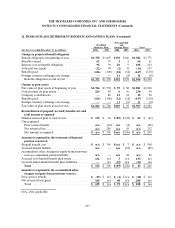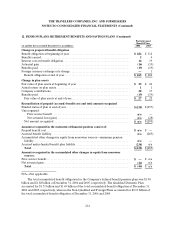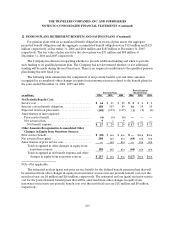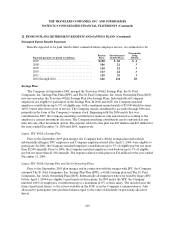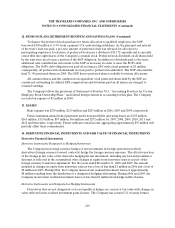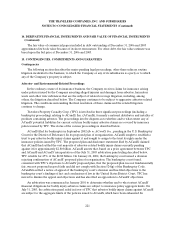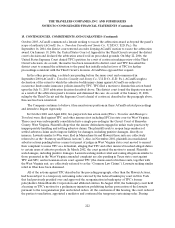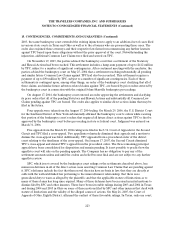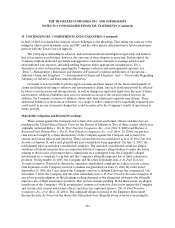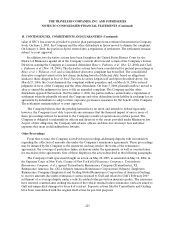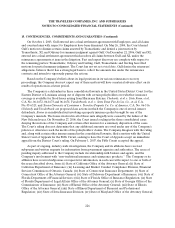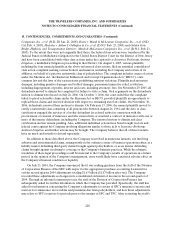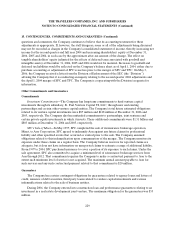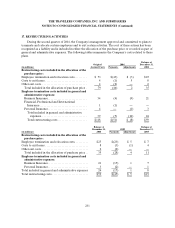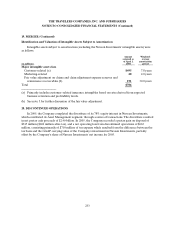Travelers 2006 Annual Report Download - page 235
Download and view the complete annual report
Please find page 235 of the 2006 Travelers annual report below. You can navigate through the pages in the report by either clicking on the pages listed below, or by using the keyword search tool below to find specific information within the annual report.THE TRAVELERS COMPANIES, INC. AND SUBSIDIARIES
NOTES TO CONSOLIDATED FINANCIAL STATEMENTS (Continued)
223
15. CONTINGENCIES, COMMITMENTS AND GUARANTEES (Continued)
2003, the same bankruptcy court extended the existing injunction to apply to an additional set of cases filed
in various state courts in Texas and Ohio as well as to the attorneys who are prosecuting these cases. The
order also enjoined these attorneys and their respective law firms from commencing any further lawsuits
against TPC based upon these allegations without the prior approval of the court. Notwithstanding the
injunction, additional Common Law Claims were filed and served on TPC.
On November 19, 2003, the parties advised the bankruptcy court that a settlement of the Statutory
and Hawaii Actions had been reached. This settlement includes a lump-sum payment of up to $412 million
by TPC, subject to a number of significant contingencies. After continued meetings with the mediator, the
parties advised the bankruptcy court on May 25, 2004 that a settlement resolving substantially all pending
and similar future Common Law Claims against TPC had also been reached. This settlement requires a
payment of up to $90 million by TPC, subject to a number of significant contingencies. Each of these
settlements is contingent upon, among other things, an order of the bankruptcy court clarifying that all of
these claims, and similar future asbestos-related claims against TPC, are barred by prior orders entered by
the bankruptcy court in connection with the original Johns-Manville bankruptcy proceedings.
On August 17, 2004, the bankruptcy court entered an order approving the settlements and clarifying
its prior orders that all of the pending Statutory and Hawaii Actions and substantially all Common Law
Claims pending against TPC are barred. The order also applies to similar direct action claims that may be
filed in the future.
Four appeals were taken from the August 17, 2004 ruling. On March 29, 2006, the U.S. District Court
for the Southern District of New York substantially affirmed the bankruptcy court’s orders while vacating
that portion of the bankruptcy court’s orders that required all future direct actions against TPC to first be
approved by the bankruptcy court before proceeding in state or federal court. Judgment was entered on
March 31, 2006.
Five appeals from the March29, 2006 ruling were filed in the U.S. Court of Appeals for theSecond
Circuit and TPC filed a cross-appeal. Two appellants voluntarily dismissed their appeals and amotion to
dismiss the cross-appeal was filed. Additionally, TPC appealed from a procedural order of the district
court relating to the timeliness of the cross-appeal. On January 17, 2007, the Second Circuit dismissed
TPC’s cross-appeal and denied TPC’s appeal from the procedural order. The three remaining principal
appeals have been consolidated for disposition and remain pending. It is not possible to predict how the
appellate court will rule on the pending appeals. The Company has no obligation to pay any of the
settlement amounts unless and until the orders and relief become final and are not subject to any further
appellate review.
SPC, which is not covered by the bankruptcy court rulings or the settlements described above, has
numerous defenses in all of the direct action cases asserting Common Law Claims that are pending against
it. SPC’s defenses include the fact that these novel theories have no basis in law; that they are directly at
odds with the well-established law pertaining to the insured/insurer relationship; that there is no
generalized duty to warn as alleged by the plaintiffs; and that the applicable statute of limitations as to
many of these claims has long since expired. Many of these defenses have been raised in initial motions to
dismiss filed by SPC and other insurers. There have been favorable rulings during 2003 and 2004 in Texas
and during 2004 and 2005 in Ohio on some of these motions filed by SPC and other insurers that dealt with
statute of limitations and the validity of the alleged causes of actions. On May 26, 2005, the Court of
Appeals of Ohio, Eighth District, affirmed the earliest of these favorable rulings. In Texas, onlyone court,


